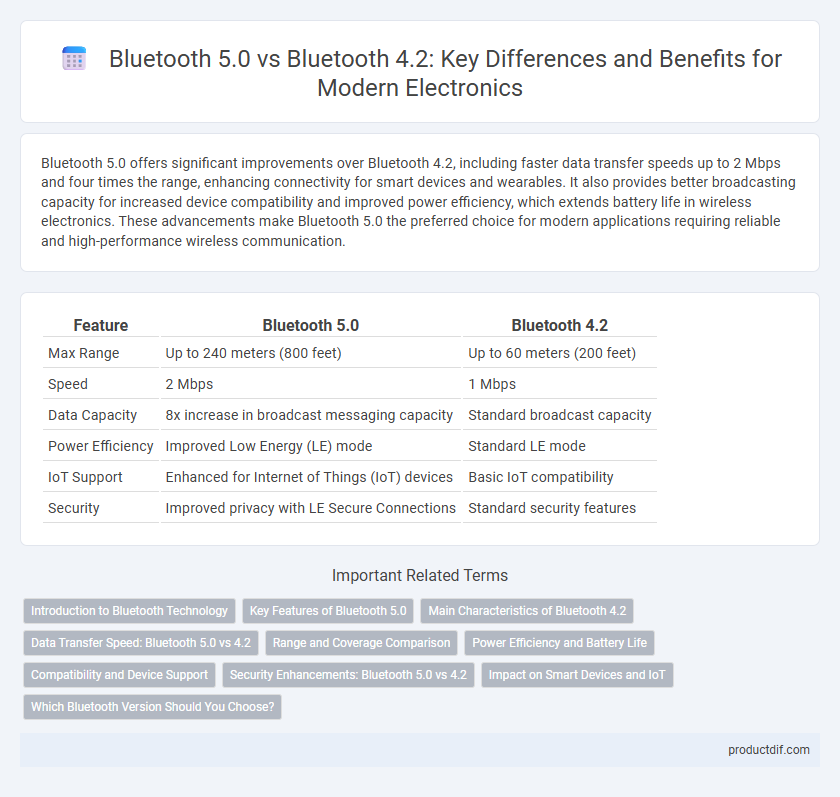Bluetooth 5.0 offers significant improvements over Bluetooth 4.2, including faster data transfer speeds up to 2 Mbps and four times the range, enhancing connectivity for smart devices and wearables. It also provides better broadcasting capacity for increased device compatibility and improved power efficiency, which extends battery life in wireless electronics. These advancements make Bluetooth 5.0 the preferred choice for modern applications requiring reliable and high-performance wireless communication.
Table of Comparison
| Feature | Bluetooth 5.0 | Bluetooth 4.2 |
|---|---|---|
| Max Range | Up to 240 meters (800 feet) | Up to 60 meters (200 feet) |
| Speed | 2 Mbps | 1 Mbps |
| Data Capacity | 8x increase in broadcast messaging capacity | Standard broadcast capacity |
| Power Efficiency | Improved Low Energy (LE) mode | Standard LE mode |
| IoT Support | Enhanced for Internet of Things (IoT) devices | Basic IoT compatibility |
| Security | Improved privacy with LE Secure Connections | Standard security features |
Introduction to Bluetooth Technology
Bluetooth 5.0 offers significant improvements over Bluetooth 4.2, including four times the range, twice the speed, and eight times the broadcasting message capacity, enabling more efficient and reliable wireless communication. Bluetooth 5.0 enhances device connectivity for IoT applications, smart home devices, and audio streaming by supporting larger data packets and improved co-existence with other wireless technologies. The upgrade from Bluetooth 4.2 to 5.0 meets the growing demands of modern electronics, providing faster pairing, increased security, and extended support for beacon technology.
Key Features of Bluetooth 5.0
Bluetooth 5.0 offers significant advancements over Bluetooth 4.2, including 4 times the range, 2 times the speed of 2 Mbps, and 8 times the broadcasting message capacity. Enhanced features like improved coexistence with other wireless technologies and increased data throughput enable more stable and efficient connectivity for modern electronics. These improvements make Bluetooth 5.0 ideal for smart home devices, IoT applications, and audio streaming with reduced latency.
Main Characteristics of Bluetooth 4.2
Bluetooth 4.2 offers a data transfer speed of up to 1 Mbps and improved privacy features compared to its predecessors, making it suitable for secure and efficient wireless communication. It supports Internet Protocol Support Profile (IPSP) for direct Internet connectivity via IPv6, enhancing device interoperability in IoT applications. Energy efficiency is optimized to extend battery life in low-power devices, positioning Bluetooth 4.2 as a reliable standard for wearable technology and smart home devices.
Data Transfer Speed: Bluetooth 5.0 vs 4.2
Bluetooth 5.0 offers a significant improvement in data transfer speed compared to Bluetooth 4.2, with a maximum throughput of up to 2 Mbps, doubling the 1 Mbps speed of Bluetooth 4.2. This enhancement enables faster and more efficient wireless communication, supporting data-intensive applications such as high-quality audio streaming and advanced IoT devices. Bluetooth 5.0 also achieves better range and reduced interference, further optimizing data transfer performance in complex environments.
Range and Coverage Comparison
Bluetooth 5.0 offers a significant improvement in range and coverage compared to Bluetooth 4.2, extending the wireless communication distance up to 240 meters in open space versus approximately 60 meters for Bluetooth 4.2. This fourfold increase in range allows devices to maintain stable connections over larger areas, enhancing user experience in smart homes, wearable technology, and IoT applications. Bluetooth 5.0 also features improved signal strength and interference resistance, resulting in better coverage in complex environments with obstacles.
Power Efficiency and Battery Life
Bluetooth 5.0 offers significant improvements in power efficiency over Bluetooth 4.2, enabling devices to maintain lower energy consumption during data transmission and idle states. Enhanced low energy modes in Bluetooth 5.0 extend battery life in wearables, smartphones, and IoT devices by up to 50% compared to Bluetooth 4.2. These advancements result in longer operation times and reduced charging frequency, making Bluetooth 5.0 a superior choice for power-sensitive applications.
Compatibility and Device Support
Bluetooth 5.0 offers enhanced compatibility with a wider range of devices compared to Bluetooth 4.2, supporting faster data transfer rates and longer range without sacrificing energy efficiency. Most modern smartphones, laptops, and IoT gadgets are equipped with Bluetooth 5.0, ensuring seamless connectivity with earlier Bluetooth versions while introducing improved device support for smart home systems and wearable technology. Bluetooth 4.2 remains compatible with many legacy devices but lacks the advanced capabilities and extended support that Bluetooth 5.0 provides for newer electronics.
Security Enhancements: Bluetooth 5.0 vs 4.2
Bluetooth 5.0 introduces advanced security features over Bluetooth 4.2, including improved encryption algorithms and stronger protection against passive eavesdropping. Enhanced privacy mechanisms in Bluetooth 5.0 reduce device tracking risks by using randomized MAC addresses more effectively. These upgrades ensure safer data transmission and increased resilience against modern cyber threats in wireless communications.
Impact on Smart Devices and IoT
Bluetooth 5.0 significantly enhances smart devices and IoT applications with faster data transfer speeds up to 2 Mbps and a fourfold increase in range compared to Bluetooth 4.2. This improvement supports more reliable connections and greater device interoperability in smart homes and industrial IoT settings. Lower power consumption and increased broadcast capacity in Bluetooth 5.0 also contribute to prolonged battery life and expanded communication capabilities for connected devices.
Which Bluetooth Version Should You Choose?
Bluetooth 5.0 offers higher data transfer speeds up to 2 Mbps, four times the range of Bluetooth 4.2, and improved battery efficiency, making it ideal for modern devices requiring fast and reliable wireless connections. Bluetooth 4.2 remains suitable for basic peripherals like keyboards and mice where extended range and speed are less critical. Choose Bluetooth 5.0 for enhanced performance in audio streaming, smart home devices, and IoT applications, while Bluetooth 4.2 suffices for simpler, low-power gadgets.
Bluetooth 5.0 vs Bluetooth 4.2 Infographic

 productdif.com
productdif.com